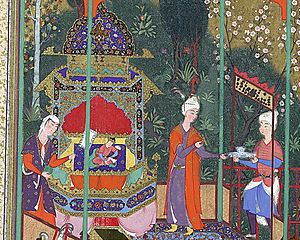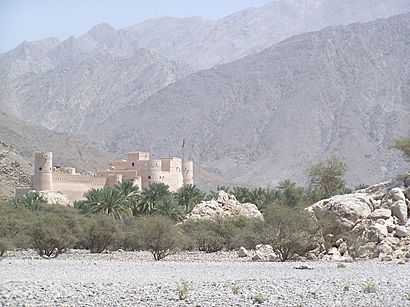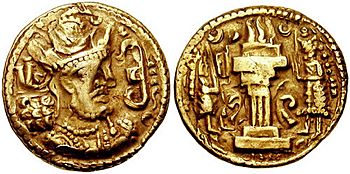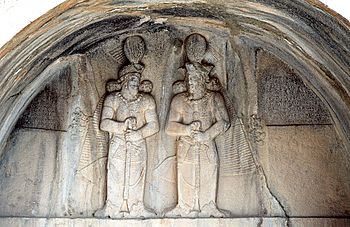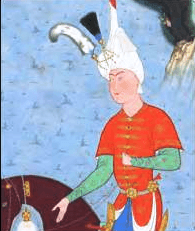Shapur II facts for kids
Quick facts for kids Shapur II𐭱𐭧𐭯𐭥𐭧𐭥𐭩 |
|
|---|---|
| King of Kings of Iran and non-Iran | |
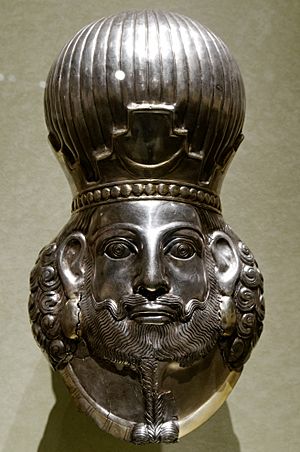
Bust of Shapur II
|
|
| Shahanshah of the Sasanian Empire | |
| Reign | 309 – 379 |
| Predecessor | Adur Narseh |
| Successor | Ardashir II |
| Born | 309 |
| Died | 379 (aged 70) |
| Issue | Shapur III Zurvandukht Zruanduxt |
| House | House of Sasan |
| Father | Hormizd II |
| Mother | Ifra Hormizd |
| Religion | Zoroastrianism (possibly Zurvanism) |
Shapur II (Middle Persian: 𐭱𐭧𐭯𐭥𐭧𐭥𐭩 Šābuhr), also known as Shapur the Great, was an important Sasanian King of Kings (Shahanshah) of Iran. He holds the record as the longest-reigning monarch in Iranian history. He ruled for his entire 70-year life, from 309 to 379 CE. Shapur II was the son of Hormizd II (who ruled from 302–309 CE).
His time as king saw the country's military grow strong again and its territory expand. This period is often called the first Sasanian golden era. Because of his achievements, Shapur II is seen as one of the most famous Sasanian kings, alongside Shapur I, Kavad I, and Khosrow I. When he was only 16, he led very successful military campaigns against Arab groups. These Arabs called him 'Dhū'l-Aktāf', meaning "he who pierces shoulders".
Shapur II had strict rules about religion. During his reign, the holy texts of Zoroastrianism, called the Avesta, were fully collected. People who went against the religion or changed their beliefs were punished. Christians were also treated harshly. This was partly a reaction to the Christianization of the Roman Empire by Constantine the Great. However, Shapur II was friendly towards Jews, who had more freedom and benefits during his rule. By the time Shapur died, the Sasanian Empire was very powerful. Its enemies in the east were peaceful, and Armenia was under Sasanian control.
Contents
What's in a Name?
"Shapur" was a very common name in Sasanian Iran. Three Sasanian kings and many other important people used this name. It comes from an old Iranian phrase, *xšayaθiya.puθra, which means "son of a king". It probably started as a title and later became a personal name.
How Shapur II Became King
When Hormizd II died in 309 CE, his son Adur Narseh became king. But Adur Narseh ruled for only a few months before some nobles killed him. They then blinded Hormizd II's second son and put his third son, Hormizd, in prison. (Hormizd later escaped to the Roman Empire). The nobles decided that the next king would be the unborn child of Hormizd II's wife, Ifra Hormizd. This child was Shapur II.
There's a story that Shapur II was the only king in history to be crowned while still in his mother's womb. The story says the crown was placed on his mother's belly while she was pregnant. However, some historians question this story. They say it's unlikely the nobles would have known the baby's gender. Another idea is that Shapur was born 40 days after his father died. The nobles then killed Adur Narseh and crowned Shapur II. This allowed them to have more control over the empire until Shapur II grew up at age 16.
Wars and Conquests
Fighting the Arabs (325 CE)
When Shapur II was a child, Arab nomads often raided the Sasanian homeland, especially the area near the Persian Gulf. At 16, Shapur II led his army against these Arabs. He fought the Iyad tribe and then crossed the Persian Gulf to what is now eastern Saudi Arabia. He also attacked the Banu Tamim tribe in the Al Hajar Mountains. Shapur II reportedly killed many Arabs and destroyed their water wells by filling them with sand.
After dealing with the Arabs in eastern Arabia, he continued his campaigns into western Arabia and Syria. He attacked several cities and even reached as far as Medina. Because he was so harsh, the Arabs called him Dhū'l-Aktāf, meaning "he who pierces shoulders". Shapur II not only made the Arabs of the Persian Gulf peaceful but also pushed many Arab tribes deeper into the Arabian Peninsula. He also forced some tribes to move to other areas. To stop future raids, Shapur II ordered a wall to be built near al-Hira. This wall became known as war-i tāzigān, or the "wall of the Arabs".
With eastern Arabia under Sasanian control, Zoroastrianism spread there. Poets from before Islam often wrote about Zoroastrian practices they learned from these areas.
Wars with the Roman Empire
Why Fight Rome?
The Peace of Nisibis in 299 CE was a "humiliating" treaty for the Sasanians. It was made between Shapur's grandfather Narseh and the Roman emperor Diocletian. This treaty gave the Romans several provinces in Mesopotamia, moving the border closer to the Sasanian capital, Ctesiphon. The Romans also gained control over Iberia and Armenia. Shapur's main goal was to undo this treaty.
Another reason for war was Rome's interference in Sasanian affairs. They supported Shapur's brother Hormizd, who had escaped prison and was welcomed by Constantine the Great. Shapur tried to make peace with his brother, but Hormizd preferred living with the Romans. Also, Constantine declared Christianity the official religion of the Roman Empire in 337 CE. He saw himself as the protector of all Christians, including those in the Sasanian Empire. This made Shapur distrustful of his Christian subjects.
Early Battles and First War (337–350 CE)
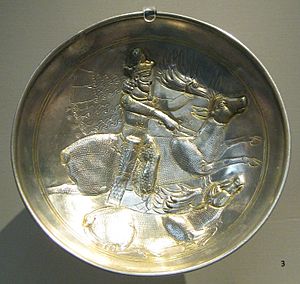
In 337 CE, just before Constantine the Great died, Shapur II started a war with Rome. He was upset that the Romans supported Roman Armenia. This began a long period of wars (337–350 and 358-363 CE).
After putting down a rebellion in the south, Shapur II invaded Roman Mesopotamia and captured Armenia. Many battles were fought. One famous battle was the Battle of Singara (modern Sinjar, Iraq). In this battle, the Roman emperor Constantius II at first captured the Persian camp. But Shapur rallied his troops and drove the Romans out with a surprise night attack (around 344 or 348 CE). A key part of this war was the strong defense of the Roman fortress city of Nisibis in Mesopotamia. Shapur besieged the city three times (in 338, 346, and 350 CE), but he was pushed back each time.
Even though Shapur II won battles, he couldn't advance without taking Nisibis. At the same time, he faced attacks in the east from Scythian tribes. He had to stop fighting the Romans and make a quick truce to deal with the eastern threat (350 CE). Around this time, the Hunnic tribes, especially the Kidarites led by King Grumbates, became a danger to Sasanian territory. After a long struggle (353–358 CE), Shapur made peace with them. Grumbates agreed to send his light cavalry to help Shapur II fight the Romans again. They notably helped in the Siege of Amida in 359 CE.
Second War and Armenia (358–374 CE)
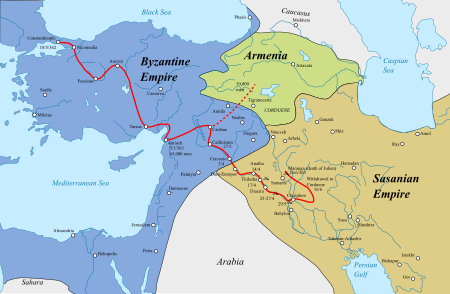
In 358 CE, Shapur II was ready for his second series of wars against Rome, which were more successful. In 359 CE, Shapur II invaded southern Armenia. However, the strong Roman defense of the fortress of Amida (now Diyarbakır, Turkey) slowed him down. Amida finally surrendered in 359 CE after a 73-day siege, but the Persian army lost many soldiers. This delay forced Shapur to stop fighting for the winter. The next spring, he continued his attacks on Roman fortresses, capturing Singara and Bezabde (Cizre?). Again, he paid a heavy price in soldiers.
The next year, Constantius II launched a counterattack. Shapur avoided a direct battle but left strong garrisons in the captured fortresses. Constantius tried to besiege Bazabde but couldn't take it. He retreated for the winter to Antioch, where he died soon after. His cousin, Julian the Apostate, became emperor. Julian wanted to get revenge for Rome's recent losses. Shapur tried to make an honorable peace, but Julian refused.
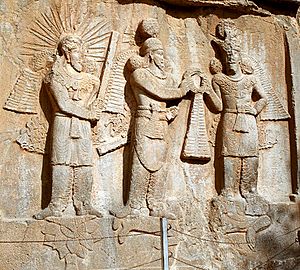
In 363 CE, Emperor Julian (361–363 CE) led a large army to Shapur's capital city of Ctesiphon. He defeated a larger Sasanian force at the Battle of Ctesiphon. However, Julian could not capture the fortified city or fight the main Persian army led by Shapur II, which was approaching. Julian was killed in a small fight during his retreat back to Roman territory. His successor, Jovian (363–364 CE), made a shameful peace treaty. This treaty gave the Persians back the lands beyond the Tigris River that Rome had gained in 298 CE, including Nisibis and Singara. The Romans also promised not to interfere in Armenia anymore.
This great success is shown in rock carvings near the town Bishapur. Under the hooves of the king's horse lies the body of an enemy, likely Julian. A Roman asking for peace, Emperor Jovian, is also shown.
According to the peace treaty, Georgia and Armenia were given to Sasanian control. The Romans were forbidden from getting involved in Armenia's affairs. Shapur took control of Armenia and captured its king, Arsaces II (Arshak II), who was a loyal ally of the Romans. Shapur tried to make Zoroastrianism the main religion in Armenia. But the Armenian nobles resisted, secretly supported by the Romans. The Romans sent King Papas (Pap), Arsaces II's son, back to Armenia. War with Rome almost started again, but the Roman emperor Valens had Pap assassinated in Tarsus (374 CE).
In Georgia, then called Iberia, Shapur II put Aspacures II of Iberia in charge of the eastern part. However, Valens managed to set up his own king, Sauromaces II of Iberia, in western Georgia. Shapur II also brought many captives from Roman territory to his lands, settling most of them in Elam. He rebuilt Susa after destroying it to stop a rebellion.
Expansion in the East
Reaching India (c. 350–358 CE)
Gandhara and Punjab
Around 350 CE, Shapur II gained control over large areas in what is now Afghanistan and Pakistan. This happened after the Kushano-Sasanian Kingdom was weakened. Important Sasanian coins found beyond the Indus river in Taxila start appearing during the reigns of Shapur II and Shapur III. This suggests that Sasanian control expanded beyond the Indus due to Shapur II's wars with the Chionites and Kushans from 350 to 358 CE. A Sasanian mint was set up south of the Hindu Kush to pay local troops. The Sasanians likely kept control until Bactria fell to the Kidarites around 360 CE, and Kabulistan fell to the Alchon Huns around 385 CE.
Sindh
In the area of Sindh, from Multan to the mouth of the Indus river, gold coins began to be made based on Shapur II's coins. These coins continued to be minted until the time of Peroz I. These coins are not the usual Sasanian imperial type. The writing around the king's portrait is in a degraded Middle Persian script. However, they have the Brahmi script character Sri ![]() (meaning "Lord") in front of the king's portrait. These coins suggest that the Sasanians had some control or influence in Sind from Shapur II's time.
(meaning "Lord") in front of the king's portrait. These coins suggest that the Sasanians had some control or influence in Sind from Shapur II's time.
Losing Bactria to Nomads (c. 360 CE)
Shapur II soon faced conflicts with nomadic tribes from Central Asia. In 356 CE, he spent his winter on his eastern borders, fighting off tribes like the Chionites and the Euseni (likely the Kushans). He eventually made a treaty with the Chionites and the Gelani in 358 CE.
However, around 360 CE, the Sasanians lost control of Bactria to invaders from the north. First came the Kidarites, then the Hephthalites and the Alchon Huns. These invaders later went on to invade India. These invaders initially made coins based on Sasanian designs. Many coins from Bactria imitate Sasanian kings like Shapur II and Shapur III. They often add the Alchon Tamgha symbol and the name "Alchono" in Bactrian script on one side. The other side shows people attending a fire altar.
Death and Legacy
Shapur II died in 379 CE. His slightly younger brother, Ardashir II, became king. Ardashir II agreed to rule until Shapur's son, Shapur III, became an adult. When Shapur II died, the Sasanian Empire was stronger than ever. It was much larger than when he became king. Enemies in both the east and west were peaceful, and Persia controlled Armenia. Shapur II is considered one of the most important Sasanian kings, along with Shapur I and Khosrow I. After a long period of instability, he brought back the empire's old strength. However, his three successors were not as successful. His death also marked the start of a 125-year conflict between the wuzurgan (a powerful group of nobles) and the kings, as both groups fought for power in Iran.
Relations with Christians
At first, Shapur II was not against his Christian subjects. They were led by Shemon Bar Sabbae, the Patriarch of the Church of the East. However, when Constantine the Great became Christian, Shapur started to distrust his Christian subjects. He began to see them as spies for a foreign enemy. The wars between the Sasanian and Roman empires turned Shapur's distrust into hostility.
After Constantine's death, Shapur II, who had been preparing for war, put a double tax on his Christian subjects to pay for the conflict. Shemon refused to pay this double tax. Shapur then pressured Shemon and his clergy to convert to Zoroastrianism, but they refused. This period began a "cycle of martyrs," where many thousands of Christians were killed. In the following years, Shemon's successors, Shahdost and Barba'shmin, were also martyred.
Barbasceminus, a bishop from 342 CE, was executed on January 14, 346 CE, along with 16 of his clergy. A Christian book from the 5th century, the Ecclesiastical History by Sozomen, gives many details about the Persian Christians who were martyred under Shapur II.
Royal Beliefs and Coins
According to a Roman historian, Shapur II fought the Romans to "re-conquer what had belonged to his ancestor." It's not clear who Shapur II thought his ancestor was, but it was likely the Achaemenids or a legendary dynasty. During Shapur II's reign, the title "the divine Mazda-worshipping, king of kings of the Iranians, whose image/seed is from the gods" disappeared from the coins. He was also the last Sasanian king to claim to be descended from the gods.
Under Shapur II, coins were made from copper, silver, and gold. Many copper coins were made using Roman metal, likely from the treasures the Sasanians took from the Romans. The weight of the coins also changed from 7.20 grams to 4.20 grams.
Cities and Buildings
Besides building the war-i tāzigān (wall of the Arabs), Shapur II also created several cities. He built a royal city called Eranshahr-Shapur, where he settled Roman prisoners of war. He also rebuilt and repopulated Nisibis in 363 CE with people from Istakhr and Spahan. In Asoristan, he founded Wuzurg-Shapur ("Great Shapur"), a city on the west side of the Tigris River. He also rebuilt Susa after destroying it during a revolt, renaming it Eran-Khwarrah-Shapur ("Iran's glory [built by] Shapur").
Important Contributions
During Shapur II's reign, the collection of the Avesta (holy Zoroastrian texts) was finished. People who went against the religion or changed their beliefs were punished. Christians were also persecuted. This was a response to the Roman Empire becoming Christian under Constantine.
Religious Views
According to Armenian and other sources, Sasanian kings respected the sun and moon. Roman sources say that Shapur II claimed to be the "brother of the Sun and the Moon." This idea is not found in Sasanian sources. It might refer to the angelic god Mithra, or it could be an Indo-Iranian belief. In this belief, kings saw their ancestors as descendants of Manuchehr and his father Wiwahvant, who were linked to the Moon and the Sun in India.
Shapur's own religious beliefs don't seem to have been extremely strict. He brought back the family worship of Anahita in Istakhr. He might have also followed Zurvanism while promoting the official version of Zoroastrianism.
Family
Shapur II had daughters, including:
- Zruanduxt
- Zurvandukht: She was named after Zurvan, a god in Zoroastrianism.
See also
 In Spanish: Sapor II para niños
In Spanish: Sapor II para niños


